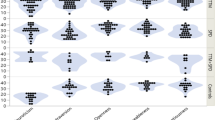Abstract
Background
The demand for minimally invasive cosmetic procedures has continued to rise, especially in Germany, yet few studies have examined this patient population. The literature in Germany has repeatedly voiced the speculation that users of minimally invasive, skin-rejuvenating procedures displayed a higher tendency toward dysmorphic behavior patterns or, respectively, other abnormal personality traits.
Objectives
The aim of this study was to investigate body image, personality traits, quality of life, and socioeconomic parameters in users of botulinum toxin and/or facial fillers.
Methods
One hundred forty-five females presented for botulinum toxin and/or soft tissue filler injections completed demographic and standardized psychometric questionnaires such as the World-Health-Organization Quality of Life-Short Form, Big Five Inventory-10, Body Dysmorphic Disorder Questionnaire before treatment.
Results
Patients undergoing injectable aesthetic treatments in an urban dermatology practice were women, middle-aged, highly educated, and mostly employed. Furthermore, participants showed higher quality of life, especially health-related quality of life, and a lower body mass index than controls. Concerning personality traits, our participants scored significantly higher on extraversion, agreeableness, openness to experience, and neuroticism.
Conclusions
This study helps to better understand the psychosocial factors characterizing this patient population. Patients differ from controls by having a higher level of quality of life. No signs of body dysmorphic patterns or problematic personality traits were found.
Level of Evidence IV
This journal requires that authors assign a level of evidence to each article. For a full description of these Evidence-Based Medicine ratings, please refer to the Table of Contents or the online Instructions to Authors www.springer.com/00266.
Similar content being viewed by others
References
International Society of Aesthetic Plastic Surgery (ISAPS) (2014) http://www.isaps.org/. Accessed 10 Mar, 2017
Deutsche Gesellschaft für Ästhetisch-Plastische Chirurgie (DGÄPC) (2004) (a) [German Society of Aesthetic-Plastic Surgery]. http://www.dgaepc.de/wp-content/uploads-/2015-/04/DGAEPC_Faktenblatt-Faltenunterspritzung.pdf. Accessed 10 Mar 2017
Deutsche Gesellschaft für Ästhetisch-Plastische Chirurgie (2014) (b) [German Society of Aesthetic-Plastic Surgery] http://www.dgaepc.de/wp-content/uploads/2015/04/-DGAEPC-_Faktenblatt-Botulinumbehandlung.pdf. Accessed 10 Mar 2017
American Society for Aesthetic Plastic Surgery (ASAPS) (2017) http://www.surgery.org/sites/default/files/2014-Top5.pdf. Accessed 10 April 2018
Deutsche Gesellschaft für ästhetische Botulinumtoxin-Therapie (DGBT) (2015) http://www.awmf.org/uploads/tx_szleitlinien/013-077l_S1_%C3%84sthetische_Botulinumtoxin_Therapie_2012-11.pdf. Accessed 10 Mar 2017
Sommer B, Zschocke I, Bergfeld D, Sattler G, Augustin M (2003) Satisfaction of patients after treatment with botulinum toxin for dynamic facial lines. Dermatol Surg 29:456–460
Fagien S, Carruthers JDA (2008) A comprehensive review of patient-reported satisfaction with botulinum toxin type a for aesthetic procedures. Plast Reconst Surg 122:1915–1925
Kiripolsky MG, Peterson JD, Guiha I, Goldman MP (2011) A two-phase, retrospective analysis evaluating efficacy of and patient satisfaction with abobotulinumtoxina used to treat dynamic facial rhytides. Dermatol Surg 37:1443–1447
Imhof M, Podda M, Sommer B (2012) Leitlinie der Deutschen Dermatologischen Gesellschaft. S1-Leitlinie: Ästhetische Botulinumtoxin-Therapie. http://www.awmf.org/uploads/tx_szleitlinien/013-077l_S1_%C3%84sthetische_Botulinumtoxin_Therapie_2012-11.pdf. Accessed 10 Mar 2017
Molina B, David M, Jain R, Amselem M, Ruiz-Rodriguez R, Ma MY, Kerrouche N, Georgantopoulos SP, Radeau T, Boineau D (2015) Patient satisfaction and efficacy of full-facial rejuvenation using a combination of botulinum toxin type A and hyaluronic acid filler. Dermatol Surg 41:325–332
Sarwer DB, Crerand CE, Magee L (2011) Cosmetic surgery and changes in body image. In: Cash TF, Smolak L (eds) Body image: a handbook of science, practice, and prevention, 2nd edn. Guilford, New York, pp 394–403
Sarwer DB (2006) Psychological assessment of cosmetic surgery patients. In: Sarwer DB, Pruzinsky T, Cash TF, Goldwyn RM, Persing JA, Whitakerm LA (eds) Psychological aspects of reconstructive and cosmetic plastic surgery: clinical, empirical, and ethical perspectives. Lippincott Williams & Wilkins, Philadelphia, PA, pp 267–283
Block AR, Sarwer DB (2013) Presurgical psychological screening: understanding patients improving outcomes. American Psychological Association, Washington, DC
Sommer B, Zschocke I, Bergfeld D, Sattler G, Augustin M (2003) Satisfaction of patients after treatment with botulinum toxin for dynamic facial lines. Dermatol Surg 29:456–460
Harth W (2006) Lifestyle-Medizin und Wunschbehandlungen. Akt Dermat 32:38–43
Sobanko JF, Taglienti AJ, Wilson AJ, Sarwer DB, Margolis DJ, Dai J, Percec I (2015) Motivations for seeking minimally invasive cosmetic procedures in an academic outpatient setting. Aesthet Surg J 35:1014–1020
Angermeyer MC, Kilian R, Matschinger H (2000). WHOQOL-100 und WHOQOL-BREF. Handbuch für die deutsche Version der WHO Instrumente zur Erfassung von Lebensqualität. Hogrefe, Göttingen
The WHOQOL Group (1998) Development of the World Health Organization WHOQOL-BREF Quality of Life Assessment. Psychol Med 28:551–558
Rammstedt B, Kemper CJ, Klein MC, Beierlein C, Kovaleva A (2012) Eine kurze Skala zur Messung der fünf Dimensionen der Persönlichkeit: Big-Five-Inventory-10 (BFI-10). GESIS Working Papers 2012|23. Köln: GESIS
Phillips, KA, Atala, KD, Pope, HG (1995) Diagnostic instruments for body dysmorphic disorder. In: New Research Program and Abstracts, American Psychiatric Association 148th annual meeting. Miami: American Psychiatric Association
Robert-Koch Institut (2013) Gesundheitsberichterstattung des Bundes. http://www.gbe-bund.de. Accessed 4 Sept 2018
Berlin Gender Report (2013) https://www.berlin.de. Accessed 10 Mar 2018
Bohne A, Wilhelm S, Keuthen NJ, Florin I, Baer L, Jenike MA (2002) Prevalence of body dysmorphic disorder in a German college student sample. Psychiatry Res 109:101–104
Author information
Authors and Affiliations
Corresponding author
Ethics declarations
Conflict of interest
The authors declare that there is no conflict of interest and there is no financial or material support by others.
Rights and permissions
About this article
Cite this article
Scharschmidt, D., Mirastschijski, U., Preiss, S. et al. Body Image, Personality Traits, and Quality of Life in Botulinum Toxin A and Dermal Filler Patients. Aesth Plast Surg 42, 1119–1125 (2018). https://doi.org/10.1007/s00266-018-1165-3
Received:
Accepted:
Published:
Issue Date:
DOI: https://doi.org/10.1007/s00266-018-1165-3



